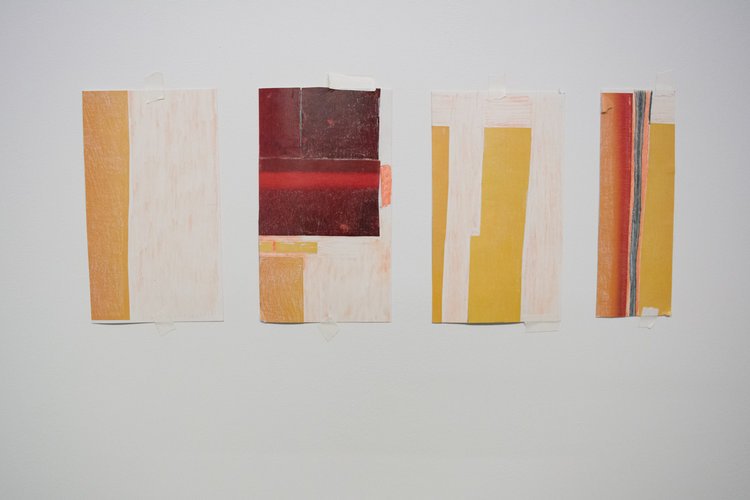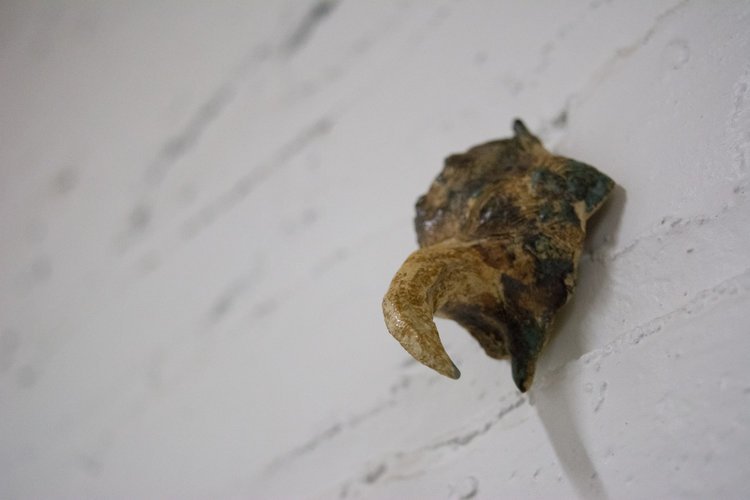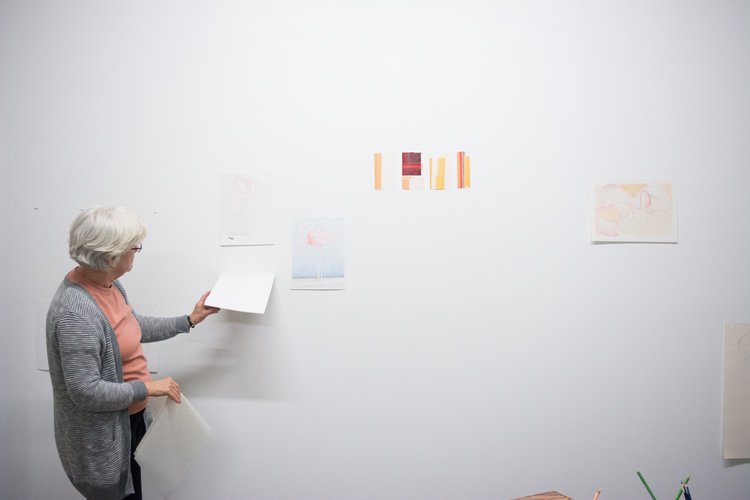Patricia Whalen-Keck is an artist working in Peoria, IL. More of her work can be found on here.
Project 1612: How would you describe the art you make?
Patricia: I have always been concerned with how, as societies we seem to build and destroy in the same breath. I think of myself as a figurative artist with an interest in the environment and ancient cultures. My work is about individuals and how they navigate through life. I model my figures in wax or clay and cast them in bronze because it is a material that connects us to past cultures, an idea that is important to me. I model both male and female figures in positions that are either standing or walking. The upright posture of the unadorned individual is by far my favorite and I have been told they embody the duel nature of vulnerability and strength. The core of my work is the isolated standing individual which is the most natural and direct posture that people take. Concerns with subject matter and choices of bird imagery add to the visual interest and content.
Project 1612: When did you start taking yourself seriously as an artist?
Patricia: Taking myself seriously as an artist was at first difficult and took much longer than expected. I started pursuing a graduate degree in sculpture late in life. While in graduate school I recall listening to a critique of my thesis work given by a visiting artist whose interpretation did not match my explanation. What I knew to be the story behind the work, what informed the piece, was not what he saw, simple enough, but for me profound. The genesis of my ideas come from my life stories, for example, the memory of doing dishes at my grandmother’s while her parakeet was perched on my shoulder was the source for The Pedestrian. I take myself seriously each time I approach a new idea.
Project 1612: What drives your practice?
Patricia: A number of things come to mind, first, the actual physical process, then researching for imagery. Recognition is always important but not what drives me. The love of art is in my DNA, the need to experience what artists have created and to create my own works. Identifying my life experiences and then connecting them to the themes that interest me drives much of what I do. The back and forth decisions that come with problem solving and of course the completed work can be very exciting. I have been in awe of artists, those who are working at a high level, thinking about and making unexpected aesthetic choices that move me intellectually and emotionally. Another aspect that drives me is my research, the search for ideas, a form or a line, and the connections with ancient works. For example, The Black Heron of South Africa was made using the direct wax method where I cast wax cylinders from discarded Pringles containers. I joined them together to create a column three feet tall, modeled a black heron and attached it to the top, and appliqued dozens of lizards on the surface. The theme became one of predator/prey. Later, while doing an online image search I discovered two miniature versions of my heron piece; one was a Udu West African musical instrument, the other a Benin bronze bird sculpture, the form of each was a cylinder showing a bird perched at the rim.
Project 1612: What problems do you face in the studio? How do you overcome them?
Patricia: My biggest concern is having enough floor space for future sculpture work, scale has become an important element in my sculpture, I don’t want to be restricted in what I can do. My new studio is a little over 520 square feet with a twenty-foot ceiling, a cement floor, and no windows. I use one wall for drawing and have plans to build a modest workbench on the adjacent wall, dedicated for printmaking. This leaves the remaining two-thirds of the space for sculptural work. The challenge is to make use of this area so that my tools and materials are easily available but the floor space is left open. I have limited the size of my work tables to smaller rather than larger and … so they can be easily rearranged, equipped them with casters. The only shelving will be on the wax wall, the area set aside for heating and modeling figures in wax. I visualize the remaining space open and filled with sculptural works in progress. I plan to keep the remaining two walls open and free of clutter.
Project 1612: What is your current body of work about?
Pat: My current body of work, in its simplest form is about drawing, exploring composition and the decisions that accompany these activities. I took a three-month hiatus from sculpture to allow myself reflective time and to process the work done as a graduate student. I am a figurative 3-D artist first but also understand the importance of learning through other disciplines. My current body of work consists of drawings of bird images and portraits of people whose life work I admire. I view the drawings as preliminary works studies for woodcuts and larger works on paper. Bird imagery shows up frequently in my sculpture so I decided to do drawings of birds that are of interest to me. I am exploring two compositional arrangements, one linear changing the proportions of a grid the other circular laying down a spiral as a starting point.
Project 1612: Can you talk about the bird imagery that shows up frequently in your pieces?
Patricia: Much if not most of my aesthetic choices originate from an actual experience or my reaction to something I heard or read. For example, In Picasso’s famous anti-war painting Guernica, Picasso placed a bird in the top left corner appearing to land on a table or, it may have been fleeing from the carnage. I taught this work to young people for many years and wanted my students to understand it as a piece of art, as well as a visual document of an actual event. The Spanish town Guernica, had been obliterated by the Nazi German Air Force, the Luftwaff, prior to the start of World War II. Picasso’s painting has been studied and written about extensively, I came across an article that had been written at the time of the bombing, the towns people were afraid to return to the village until the birds returned. I shy away from talking about the symbolic meaning of birds and why I use them though I acknowledge they act as a signifier. Other memories that inform my use of bird imagery include that of growing up with parakeets, not caged but allowed to fly freely through the house, the flamingo deco in my grandmother’s house, my mother’s romantic interest in swans, my sisters’ talents as musicians, to sing and to play the piano. The choice of what music I play in my studio drives my thinking.
Project 1612: You are a sculptor, but have also been exploring printmaking, drawing, and collage. How do you connect the 3D and 2D aspects of your work?
Patricia: Yes, I have been exploring printmaking, drawing and collage. I find similarities in the processes, the research and of course the subject matter. Working in multiple disciplines helps to keep my thinking fresh, to not become predictable. I truly enjoy the challenge that comes with using different materials. And, of course, casting a work in bronze is very expensive, it requires hours of time and physical labor to complete. At this stage in my live I felt it important to explore activities that are physically less demanding.
Project 1612: How long has your studio been at The Mill? And how does this studio space differ from previous studios?
Patricia: I have been at The Mill four years. The owners were just beginning to develop studio spaces for the art community when I rented a small space. I was looking for a quiet area to read, do research and eventually write my thesis paper. I was one of a handful of artists to first locate in the building. This space was located on the second floor and well suited for quiet reflective work. Upon completion of my degree, I needed a larger studio to do sculpture, fortunately a ground floor studio became available. Though still small for a sculptor the new space has been ideal for me. It is still quiet, with the same finished white walls and solid wood beams, and easily accessible from the parking area. I am now located at the back of the building directly across from a local pottery.
Project 1612: What advice do you have for aspiring artists?
Patricia: I would advise aspiring artists to know the what, the why and the where.
Project 1612: What are your thoughts on the art community in Central IL?
Patricia: My art community experiences are limited to towns I have live in or lived close too; Decatur, Peoria, Bloomington/Normal, and Champaign/Urbana, the latter two, university towns. While living in Decatur, and now in Peoria, I had the good fortune to meet, work with and learn from two highly accomplished artists, both long-time residents of Central Illinois. Both artists are connected to the larger art communities of Lithuania and California, and the current art community in Chicago. My work practice includes looking at art, museum quality and contemporary works. It is an easy drive to Krannert Art Museum on the campus of the University of Illinois to view their graduate shows, current exhibitions and collections. I often travel by train to visit Chicago; University Galleries is located next door to the train station so I visit it as often as possible. The Contemporary Art Center of Peoria was founded in 1998, areas for artists to work, exhibit and sell are continuing to increase, and the Peoria art community is engaged in exposing young people to the arts. From what I have experienced the arts are alive and well in Central Illinois. I have managed to find in Central Illinois what I require to work, but frequently seek the energy of a metropolitan environment.









